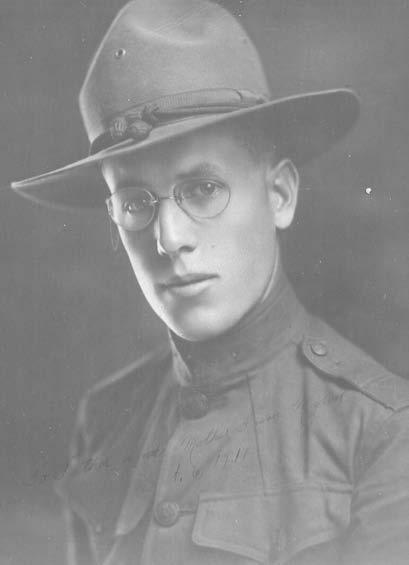
32 minute read
Health Care in Millard County: The Medical Career of Myron E. Bird
Health Care in Millard County: The Medical Career of Myron E. Bird
By DAVID A. HALES AND DOROTHY BIRD KILLPACK
Night has fallen on the small rural community in west Millard County and four people have gathered in a home including Myron E. Bird, M.D., attending physician; a neighbor woman who is there to assist in the administering of ether; the mother who is about to deliver her baby; and the father who is holding the kerosene lamp to provide light for the room. Dr. Bird recalled, “The father was holding the lamp over my shoulder and the baby was almost there when I noticed the light swaying. The father fainted and, when he fell, the lamp broke and set the floor afire. There I was delivering the baby with one hand, waving the woman with the ether can away with the other hand, and trying to stamp out a fire with my feet.” 1 Fortunately, the ether failed to explode, the fire was quickly controlled, the father regained consciousness, the mother recovered, and a healthy baby was delivered into the world without complications.This is one of many experiences Dr. Bird had while providing medical care and community service to the people of west Millard County, Utah, for more than fifty years.
In the early days of his practice, Dr. Bird delivered most babies in the homes of his patients—as many as nine during an unusual twenty-four hour period. As Dr. Bird recalled, “Two were in Oak City, two were in what we called South Tract, two were in the hospital in Delta, and the others were born at Sutherland and Sunflower, and all those places are several miles apart.” The exhausted Dr. Bird arrived home about 9:00 a.m. on a Sunday morning after the deliveries just in time to receive an anxious telephone call from someone asking if he was going to sing with a quartet at a church meeting. Dr. Bird responded, “Nope! I just had nine babies and I’m going to bed!” 2

Myron Bird in his World War I Uniform 1917-1918.
ALL PHOTOGRAPHS COURTESY OF DOROTHY BIRD KILLPACK
Myron Evans Bird was born in Manti, Utah, on June 25, 1896, the last of the nine children born to Charles Heber Bird and Alice Ann Evans Bird. His father worked as a freighter until his leg was amputated due to complications resulting from a skating accident when he was a teenager. Charles then took dental instruction and supervised training sessions from a dentist traveling through the area and from two dentists in Salt Lake City before hanging out his own shingle. During the summer months, young Myron helped his father with his dental practice, loading the dental chair in the wagon and traveling with his father visiting the small central Utah rural towns along present Highway 89. 3
Myron remembered with fondness the many times his entire family would gather around the old piano in the parlor and sing together for hours. Such sessions helped establish a strong bond between Myron and his brothers and sisters, which lasted throughout their lives. The family singing sessions also established his understanding of and love for music. 4
Myron received his early education in Manti.When he was in the eighth grade, he developed appendicitis. At that time appendicitis was difficult to diagnose and required major surgery. When his appendix ruptured, he was transported to Salt Lake City for emergency surgery on the snail-paced Sanpete train that stopped at every community. According to the then proper medical procedure, a patient was not allowed to have any food for ten days following the surgery, and then they were to have a little gruel and soup for a few days, gradually building to larger amounts and more substantial meals. Following Myron’s surgery, a nurse mixed the dietary orders and brought Myron a tray filled with everything from soup to nuts. Famished, Myron thought it was providence and over-ate. By nightfall he had developed a full-blown case of peritonitis. “I was in the most severe pain imaginable and every two minutes for two weeks, when a peristaltic wave tried to force stool past a complete stoppage in my small bowel, I would scream until I about emptied the L.D.S. Hospital.” 5
For two weeks the attending doctors did not understand why Myron was not dead.The preservation of Myron’s life came when a humble orderly stepped into the room where Myron was lying semiconscious with his mother holding his hand and asked: “Sister Bird, I feel I must give your son a blessing. Do you mind?” According to his mother, Alice Ann, the orderly gave Myron an impressive blessing in which he said, “You will not die. You will live to be a healer of men.”6 Later that evening, Myron felt a jerk throughout his entire body. He opened his eyes and asked for a drink of water. In time he regained his health.
After high school in Sanpete County, Myron attended LDS Business College in Salt Lake City where he became highly proficient, typing ninety words a minute, and where he studied bookkeeping. While attending school, he worked part-time operating an elevator at the Hotel Utah and delivering telegrams for Western Union. The Western Union job also included delivering dinners from local cafes to whoever called requesting a meal. He often delivered dinner trays, balancing them on his head while riding his bike. Most of the dinner clients were local madams. 7
After graduating from the LDS Business College, Myron found employment as a bookkeeper in a granite quarry in Little Cottonwood Canyon. When World War I broke out in Europe, Myron volunteered for military service. Before he reported for duty on Monday, August 5, 1917, he spent his last few days of civilian life in Manti with his family and friends. He spent most of the time courting Romania Westenskow.
Romania, born January 6, 1898, was the oldest of the six children born to Peter Westenskow and Frances Ann Bench Westenskow. She and Myron had known each other all their lives and during his short visit home they decided to marry. The marriage ceremony was hurried. Sunday morning, August 4, was conference in Ephraim for the members of the Sanpete Stake of The Church of Jesus Christ of Latter-day Saints. They wanted their bishop to perform the marriage, and word was sent to Ephraim for him to return during the break between sessions of the conference. Romania and Myron were married at the Westenskow home and then caught the evening train to Salt Lake City.
The following Monday morning Myron was inducted into the U.S. Army, 145th Field Artillery, where he was assigned to play the tuba in the unit band and to his regiment’s first-aid unit. He was sent to Camp Kearny near LaJolla, California, for training where Romania joined him two months later. During the next few months, they rented various places around the area. Myron was able to spend most weekends with Romania.8
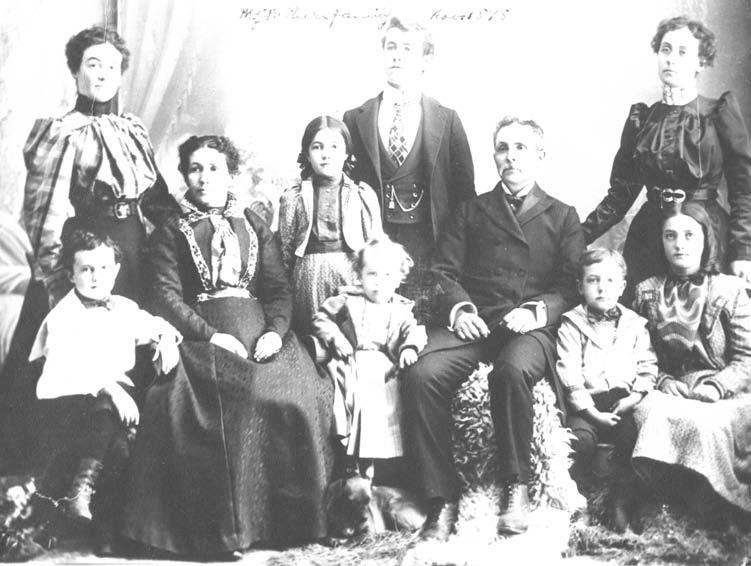
The Charles Heber Bird Family. This photograph was taken in Manti in November 1898. Two year-old Myron is standing between his mother, Alice Ann Evans and his father, Charles Heber Bird who are seated. other family members include- back row, left to right, Harriet, Blanche, Charles, and Charlotte. Front row, Kenneth, Myron, Heber and Ephia.
In July 1918, the 145th Field Artillery Band was detailed to make a trip to Utah to perform concerts in various towns to raise money to support the war. Romania, who was pregnant with their first child, traveled with him. While in Utah they were sealed in the Manti LDS temple.
A month later Myron crossed the country on a troop train to New York where he and hundreds of other American soldiers boarded ship and sailed first to England, then to Ephia. France, where the war was raging.9 Myron was stationed at Base Hospital No. 6, just east of Bordeaux. There he wrote, “This is a mighty fine camp, good straw ticks and wooden bunks, some relief from what we have had since we left the U.S.A. There is a hot and cold shower bath, oh what bliss, we have not seen one on this side of the pond until this.The eats are fine too and a mess hall to eat in.” 10
His regiment was a reserve first-aid unit, which assisted wounded troops and soldiers suffering from the Spanish influenza epidemic. On Wednesday, September 25, 1918, he wrote, “We went down and carried stretchers and believe me it is some job. We worked from midnight until 4:30 a.m. and handled 450 patients. Most of them were sick with influenza and pneumonia. One of them had died and I had the experience of helping lay out my second stiff in my life. They were passing away and being buried so fast that sometimes they were buried only in blankets without coffins.”11 Myron was also stricken with the deadly flu but again his life was spared and he recovered. 12
It is estimated the five years of grinding war killed approximately twenty million people while worldwide twenty to fifty million people died from the Spanish flu. Deaths among Utah soldiers during World War I totaled 633—of those 219 died in combat and 414 by disease including the flu. 13
Myron’s regiment was preparing to rotate to the front lines when the armistice was signed on November 11, 1918. His regiment was then sent to Bassens, France, where they worked as dock hands on the wharves at Gradingnon on the Bay of Biscay. On Christmas Eve they boarded a ship for the United States and home. “I will never forget the time we had trying to navigate our way out of the bay, which was heavily mined….The wind was blowing a gale and the boat almost laying on its side.” 14 Myron finally arrived safely in New York Harbor on January 4, 1919. There he and the others were deloused and spent two days in quarantine before resuming their journey home.
Prior to leaving France, Myron did receive some good news. “We arrived at camp just at supper time and you can imagine my delight at receiving a cablegram from my wife telling of the birth of my son. The cable had been delayed several days in Paris and had been held in camp for me for sometime so it was nearly a month old when I received it but it was mighty welcome news never-the-less.” 15
After the war, Myron and Romania settled down in Salt Lake City where he worked for a short time as an auditor for the LDS church and then for Mount Nebo Marble Company. For a brief time he and his brother Heber operated a small grocery store on Third Avenue just east of F Street. The business, however, was not successful. A barber, whose shop was in the same building as the store, convinced Myron that he was not cut out to be a merchant and suggested that he turn his energy to the study of medicine. As a twenty-six year-old father of two children and afflicted with hemorrhaging ulcers, he was able to obtain funding and enrolled in the University of Utah. Romania made hats and took in sewing providing much needed income. Myron graduated from the University of Utah with a bachelor’s degree on June 9, 1925, with anatomy as his major and mathematics and music as minors. 16 Myron and his family then moved to Chicago, where he enrolled in the University of Illinois Medical School. He worked part-time selling shoes at Marshall Fields Department Store while Romania cared for boarders and continued to make hats and take in sewing. Times were lean for the young family. Romania’s family in Utah sent the family eggs and butter whenever possible; Myron’s family sent a dollar now and then as well. They managed to survive. While in Chicago they became good friends with other Utah couples, including Herbert and Florence Maw, Scott and Adele Matheson, and Elmo and Rhea Eddington as they all struggled to complete their studies in Chicago. 17
Myron graduated in July 1927, and immediately began a residency at St. Joseph Hospital in Chicago. After completing his residency he was offered a position in Chicago for three thousand dollars a year—a good salary in those days. However, as originally planned, the family moved back to Salt Lake City, where Myron worked as a general practitioner with Herond N. Sheranian, M.D. in the Murray Hospital. For various reasons, he was not happy in this practice. His brother, Charles William Bird, a dentist, introduced him to Dr. Bernard Smith from Delta, who was looking for a physician to buy his practice and hospital so he could move to California.
Myron and Romania, who was pregnant with their third child, traveled to Delta to look over the situation. Myron was uncertain with the financial situation, but Dr. Smith promised to pay Myron for his assistance on twenty tonsillectomies Smith had scheduled. Myron could then use his pay for the down payment on the practice, hospital, and home. With that settled, Dr. Bird, Romania, and two children, Evan and Dorothy, moved to Delta on February 5, 1929. Their third child, Don, was born a month later on March 7. Romania was content. She knew this was the place they were intended to be because she had seen it in a dream. 18
Before the arrival of Myron and Romania to Delta, west Millard County farmers had mixed financial success. During and immediately after the Great War, county farmers doubled the number of acres under the plow. The additional land yielded a good quantity of alfalfa seed and sugar beets. Taxes increased and farmers borrowed heavily to buy more land and seed. But both crops required large quantities of water. Added irrigation coupled with poor drainage resulted in much of the farm land becoming water logged and impregnated with alkali, radically reducing crop yields. To solve this serious problem, local irrigation companies issued bonds to construct expensive drainage ditches even as farm prices dropped dramatically. Coupled with the Great Depression, farmers in Delta and elsewhere experienced a prolonged and serious drought. 19
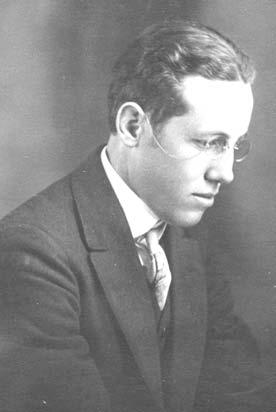
Myron Bird at the time of his marriage—August 4, 1917.
Heavily in debt and with little money in circulation, people in Delta during the Great Depression frequently paid their medical bills with produce, meat, bags of alfalfa seed, and even a thoroughbred race horse.20 Years later Dr. Bird received some payments for his earlier medical services, often with a note apologizing for being so late and also thanking him for not pressing them for the money.21
Soon after moving to Delta, Dr. Bird came to realize that life was hard in this part of the world and that he needed to step outside his medical role to help the area survive and be successful. Romania also understood their unique role and was supportive in their involvement in the community. People of Delta had a lot of confidence in Dr. Bird and his ability to get things done. They elected him to the town board and within two months of his election the town board appointed him mayor when the elected mayor moved away. Shortly after Dr. Bird was appointed mayor, the Delta State Bank closed leaving Delta without funds to operate. However, both Dr. Bird and the city council continued to serve without pay. At the end of his appointment as Mayor, Delta voters elected Dr. Bird as their mayor for a full term. 22
As the area’s only doctor during the decade of the 1940s, Dr. Bird saw a broad range of ailments. During a two-month period he attended twenty-five patients with pneumonia, more than two dozen of them were simultaneously afflicted with typhoid fever. He performed countless appendectomies, gall bladder surgeries, hernia repairs, tonsillectomies, and pelvic surgeries. He saw innumerable cases of childhood measles, mumps, and chicken pox, and, of course, set many broken bones.The Bird children were often called to assist in providing the traction for setting bones. One apparently successful method Dr. Bird used to set broken bones was to use old window sashes as weights to put fractured legs in traction. 23
In the course of his career, he delivered more than five thousand babies and was proud that less than one-tenth of 1 percent of the babies and fewer than six mothers died, due to birthing complications for which medical interventions were not available. 24
He also comforted the bereaved. Often, the last request of his patients was for Dr. Bird to speak or sing at their funeral. For many years, he was the only doctor many patients in west Millard County ever knew. It was not unusual, toward the end of his medical career for Dr. Bird to treat four generations of family members.
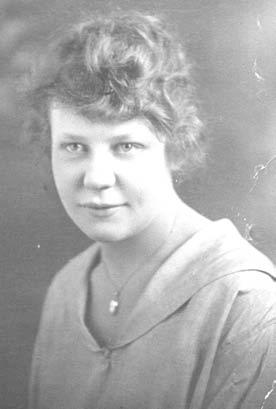
Romania Westenskow Bird at the time of her marriage.
Once when a sheepherder accidentally shot himself in the palm of his hand with a rifle splintering the bones, Dr. Bird did what he could to fix the splintered hand and suggested that the shepherd see a specialist in Salt Lake City. Years later, the sheepherder confessed that he had never gone to the specialist. “He reached out to grip my hand,” reflected Dr. Bird, “and showed me that the hand that had been injured really worked well.”25 Another time, a patient was brought in with a broken back. Dr. Bird hung the man from the doorframe to put a cast on his back.
Eldon Poulsen, a former Delta resident, recalled a time when his father was operating a new disc with a team of horses on a field in Sugarville. Poulsen’s six-year-old brother, Don, jumped on the disc for a ride but fell and the sharp disc edge sliced through his foot, making a diagonal cut between the heel and the ankle bone that nearly severed the boy’s heel.The family rushed him to a doctor in Delta located about fifteen miles away. The doctor there said, “The only thing I can do is cut the heel off and he will be a cripple for the rest of his life.” Poulsen remembered that his dad said, “No! Not by a damn sight. We will go see another doctor.”26 The senior Poulsen took little Don to Dr. Bird, who said since there were no broken bones he would try and save the foot. “He put Don out and worked for over four hours sewing and repairing the foot. He put over 132 stitches in the foot to put it back together. They kept Don in the hospital for a couple of days, and then let him come home. Dr Bird taught mom how to care for the injury and after a few weeks Don healed up and was as good as new. . . . He never suffered from a limp until he was 65.” 27
On another occasion he saved two small grandchildren of Mrs. Clarence Prestwich, Michael and Daryl Tureson. Mrs. Prestwich had left the house to feed the chickens and when she returned the children had opened a bottle of Black Leaf “40”, an insecticide. One boy had stains of the poison around his mouth. While she was wondering what to do one boy toppled over on the floor and passed out from the poison. She rushed them to Dr. Bird who worked on one of the children while his nurse, Shirley Harris, worked on the other clearing their stomachs with stomach pumps. The quick action of Mrs. Prestwich and the immediate attention the two boys received at the hands of Dr. Bird and Shirley Harris saved the boys, both eventually fully recovered. 28
Dr. Bird went beyond the call of duty to help others. Barbara Ashby recalled that, when her sister’s husband died of a heart attack, Dr. Bird called Barbara at her home to tell her of the death and sent her to be with her sister so she wouldn’t be alone. 29
Lois M. Maxfield remembered that during the Great Depression, Dr. Bird “dispensed much needed hope and encouragement along with the medicine. . . . Dr. Bird was a man who made a great difference in the rough years!”30 When her little daughter pushed a chair to the coal range and tipped a pan of hot water over herself, “Dr. Bird came as soon as we notified him and began treating her severe burns. He came daily to dress her wounds. She did not scar as a result of this treatment.” 31
He was wonderful with children and would take the time to examine their dolls, if they had one with them. When he was dictating his hospital records, he would always finish with a joke. When talking to a boys’ health class at school, someone asked, “Can you get syphilis from a toilet seat?” Dr. Bird answered: “I think that would be a crazy place to take a girl.” 32
During the Great Depression the Works Progress Administration (WPA) established three camps in the Delta area. As mayor, Dr. Bird was influential in getting WPA funds for a recreation hall (later called the Palomar), and an adjacent ball park. These facilities were the center for church, school and community activities for many years and are still in use.The energetic camp workers did an impressive range of other much needed projects such as rainwater catchments, erosion repair, dead tree removal, road grading, camp-site construction in the canyons, and sidewalks and street lights installation. The government supplied doctors for the three camps, but the Delta hospital was the only hospital in the western portion of Millard County that could handle major medical problems and surgeries.The influx of new patients stretched the six-bed hospital to the limit. Often patients were placed on cots in the hallways; and as soon as surgeries were completed cots were placed in the operating room.
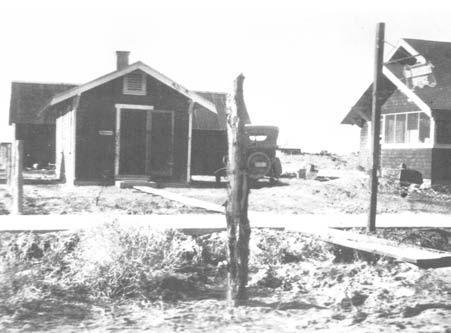
Doctor Bird's office and hospital in Delta.
During World War II, the federal government built Topaz, a Japanese American internment camp, sixteen miles northwest of Delta. At the time, about four thousand people lived in west Millard County. The population of Topaz soon reached 8,130, making it the fifth-largest city in Utah. Early in its existence, the internment camp was without any doctors or hospital and, as a result, Dr. Bird’s practice tripled. Often the Delta hospital became too crowded with patients. Examining tables were used as patient beds and cots were put in the halls for the same purpose.34 Shorthanded, Dr. Bird hired a young Japanese woman to help with the medical work and stated that she was “the most efficient employee we ever had.”35 He believed that hiring her built rapport between him and the people interned at Topaz.
Dr. R. H. Merrill from the LDS Hospital in Salt Lake City came to Delta once a month to do eye surgery. Eventually, the federal government provided doctors and built a hospital at Topaz.The camp hospital’s facilities and supplies were far superior to those that Dr. Bird offered in Delta.
Dr. Bird spent time with his patients to explain their medical problems and to listen to their concerns. He believed listening was a large part of patient care. He was known as being “the most patient and impatient man alive.” He would listen to his patients for hours, even when the waiting room was filled with other patients. This greatly annoyed Romania. However, when he wanted something done, it had to be done immediately.
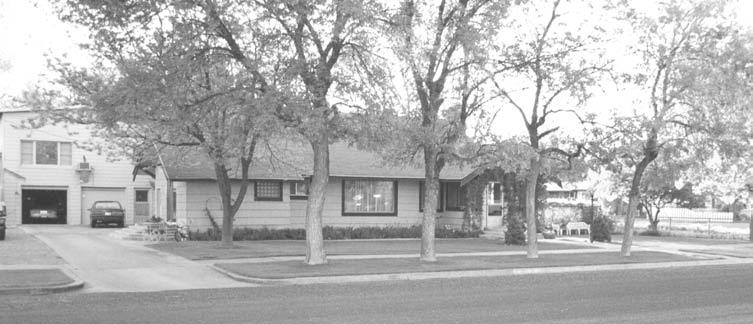
The Bird Residence in Delta at 108 South 200 West was built in 1915.
During his career, Dr. Bird developed a practice of grouping elective surgeries in surrounding communities for greater efficiency. For example, he would travel to Oak City, to perform tonsillectomies on a group of children usually with the kitchen of a local family serving as his operating theater. Mirrors were positioned to direct light from kerosene lanterns to the operating (kitchen) table. As his practice became more established, he required patients to come to the hospital in Delta.
He was also creative and innovative in other ways. He devised a bed for women in labor: the patient used a belt to hold her legs aloft. For those patients who had pneumonia, he rigged up a system that bubbled oxygen through a flask of water to keep the patients’ airways from becoming desiccated.36 To control a diarrhea outbreak at Topaz, he put together ingredients in a concoction so effective that he used it until the end of his practice. He also developed a salve for burns and a prescription for ulcers.
For many years, Dr. Bird gave student athletes free physicals and was supportive of all school and community events. He also started the first school immunization program in the Delta area, traveling to the seven different schools and giving the shots himself without pay. He wanted to make sure that those who could not afford the immunizations would be able to receive them anyway. The development of pharmaceuticals greatly enhanced medical treatment. Dr. Bird recalled in an interview in 1983 that the greatest progress that impacted his medical practice was the number of new drugs that became available. “When I first started practicing medicine, there were three or four drugs [I] relied on.”37 The first dose of penicillin in Millard County cost thirty dollars because the antibiotic was so scarce. Dr. Bird felt that the greatest breakthrough in surgery was in anesthetics. Only ether and chloroform had been available when he started practicing, and it was common for a doctor to lose a patient from an overdose.
Dr. Bird made many improvements to his hospital to meet the changing health codes through the years. When he first purchased the hospital, the fluid discharges from the laboratory sink drained through the wall directly into an open cesspool. The toilet facilities were outside and there was no central heat. He made all the improvements with his own money until 1963, when the community voted to build a new hospital supported by tax money. He donated his own equipment to the new facility. 38 When the current hospital was built in 1984, he helped with the planning and again made a sizable financial contribution to the building fund.
Dr. Bird experienced some close calls during his long and distinguished medical career. During the winter of 1949, he and his wife were caught in a blizzard south of Eureka where their car became hopelessly buried in deep snow drifts. Hours later they were rescued. On one occasion he fell downstairs while calling at an unfamiliar house.While Dr. Bird was making one of thousands of house calls, a tire blew on his car causing him to lose control ending up in a nearby irrigation canal. Returning from Hinckley where he was called to delivery a baby, he dozed off at the wheel as he approached the busy railroad tracks immediately west of Delta. Fortunately, the train engineer blew the train whistle and Dr. Bird managed to stop his car before reaching the tracks.
During his practice of more than fifty years, Dr. Bird was sued only twice. In both cases there was no merit and his insurance company settled out of court. In the first case, a young boy’s parents took him home prematurely from the hospital, concerned that they would not be able to pay the hospital bill. The medical problem became more serious and could have been treated had the boy remained under the doctor’s care in the hospital.
In the second case, a man and woman were brought to the hospital from an automobile accident west of Delta. The woman had been pinned beneath an overturned car and complained of severe shoulder pain at the hospital. She refused to let Dr. Bird take an x-ray and without the x-ray he was unable to properly diagnose or treat her injury. The couple went on their way but later returned with an x-ray showing that the shoulder was indeed broken.They filed suit for the lack of treatment and again Dr. Bird’s insurance settled the matter. The couple was later arrested in the Midwest where they were making fraudulent claims for false accidents and injuries.
Dr. Bird was involved in many other activities. He was an avid hunter and fisherman and was still hunting deer at age eighty. Fish Lake was one of his favorite retreats. He was a painter who painted winter or Christmas scenes each year on his home’s picture window. He found time to plant and care for a flower and vegetable garden around his home and had a farm outside Delta.Working in the soil was very therapeutic for him.
Although a member of the Mormon church, he was inactive as a young adult, but later became active serving as Sunday School Superintendent in the Delta First Ward, on the Deseret Stake High Council, and as bishop of the Delta First Ward for six years beginning in August 1949.39 During his time as bishop, he spent countless hours overseeing the plans and construction for the new Delta First Ward chapel, pitching in to do some of the carpentry work, shingling the roof, and painting. He and his counselors conducted many successful fund-raising parties including Saturday night square dances that became known throughout the valley. 40
Music was always a means of personal expression for Dr. Bird. He sang as a soloist, in quartets, and with the Deseret Sentinels, a local men’s choir, and directed the Delta First Ward Choir. 41
In January 1951, Dr. Bird, as bishop, organized the “Sunshine Club” to provide fellowship and meaningful activities for the many widows in the Delta First Ward. Each club member was responsible for making regular contacts with other members and encouraged members to participate in various activities. They made and sold quilts to support LDS missionaries and servicemen at Christmastime, repaired the church song books, purchased cooking utensils for a member who lost everything in a fire, and gathered clothing for the patients at the Utah State Mental Hospital. These activities helped club members feel needed and kept them in contact with other church and community activities. 42
Dr. Bird was a charter member of the Delta Lions Club, founded in 1931, and was actively engaged in a number of Lions Club community projects. Through the Lions Club, he helped convince state and federal government officials to route Highway 6 through Delta and helped to raise funds to construct the highway. Dr. Bird and others felt that having the road through Delta would bring tourists and other economic development to the area. He made trips to Chicago and Washington, D.C., and neighboring states, and called upon his college friend, former Utah Governor Herbert Maw, for assistance. As a Lions Club member, he also helped start the Millard County Junior Livestock Show. In 1978, he was the recipient of the prestigious Utah Lions Humanitarian Award presented “For a lifetime of service and giving of his time, talent and material means for the betterment of his community, his state, and his nation.”43

The Delta Hospital.
In the 1980s,Utah Governor Norman H. Bangerter appointed Dr. Bird to serve on the first Utah Council for the Aging, and he helped establish the Millard County Senior Citizen group. The senior citizen building in Delta, constructed in 1978, is named after him. 44
Millard County residents praised Dr. Bird for his lifetime of service. Bud Huff reflected, “There is an old saying, ‘If you want something done, find the busiest man in town.’ That was Dr. Bird. He was a good doctor and busy, but he still found time for others.” 45 Eldon Poulsen wrote, “Dr. Bird was a great man, a dedicated doctor and a servant to his fellow man. We are all a little better people because he was here with us.”46 Roberta Lovell Dutson summarized his contribution, noting:
Romania was always at Myron’s side, a great supporter of all his activities including full participation in his medical practice. She became the receptionist for his office and the hospital, kept the medical records, served as vital statistics registrar for birth and death certificates, and acted as surgery scrub nurse, surgery assistant, and x-ray technician. She also helped sterilize the instruments and linens used in surgery and obstetrics—using a pressure cooker during the early years. She planned the meals for the hospital patients, ordered the food and medical supplies, collected fees for services, and paid the bills. 48
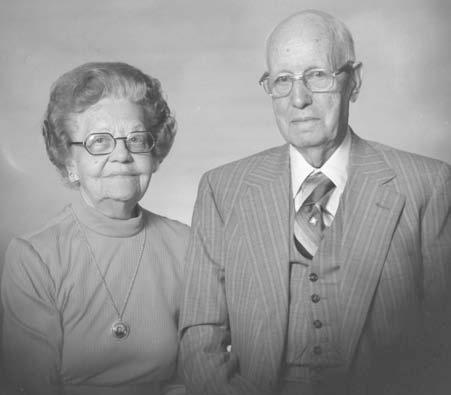
Myron and Romania Bird on their sixty-fifth wedding anniversary— August 1982.
She was also very active in the LDS church, and the Women’s Relief Society was one of her favor ite organizations. A member of the Lady Lions, she supported her husband in his civic responsibilities as well. She was an active member of the Fidelity Club—a local literary club, and she always enjoyed playing bridge and rook. Dr. Bird officially retired from his medical practice in October 1983 after fifty-four years of practice, but continued to see patients almost until the day he died in Provo, on December 30, 1984. Near the close of his life he said, “Practicing medicine was to me a God-given privilege, and I felt obligated to do the best I could to help humanity the best I know how.” 49
Romania survived him by almost nine years, suffering from rheumatoid arthritis in later years. She died November 20, 1993, and is buried in the Delta City Cemetery next to her husband.
The world they left in the late twentieth century was very different from the world they entered. At least part of the changes for good experienced by the people of west Millard County between 1929 and 1984 and even today came as a result of the commitment and compassion of Myron and Romania Bird.
NOTES
David A. Hales is a librarian, Westminster College, Salt Lake City. He was delivered by Dr. M.E .Bird in Oak City, Utah, at the home of his maternal grandparents, Abe Roper and Rachel Rawlinson Roper. His aunt, Mable Roper Schick, was the attending nurse. She worked for Dr. Bird in the Delta Hospital for several years. Dorothy Bird Killpack is the daughter of Dr. M.E. and Romania Bird. She graduated from the LDS Hospital School of Nursing and assisted her parents at the Delta Hospital for many years. The authors wish to thank Michele Swaner for her editorial assistance.
1 Steve Hale,“A-`Bird’-of a Team,” Utah Medical Bulletin, March 1974,2.
2 Ibid.,3.
3 Dorothy Bird Killpack, A Man of Great Service:Dr.Myron Evans Bird (Delta:n.p.,1983),2.
4 “Autobiography: Myron Evans Bird,”1959,1;typescript in the possession of Dorothy Bird Killpack, Delta.
5 Ibid.
6 Ibid.
7 Killpack, A Man of Great Service, 2.
8 “Autobiography,” 2.
9 Ibid.
10 Myron Bird.“Diary Written While in France WW I”,2.Transcribed and in the possession of Dorothy Bird Killpack,Delta,Utah.
11 Ibid..
12 “Autobiography,”2.
13 Noble E. Warrum, Utah in the World War (Salt Lake City: Utah State Council of Defense,1924),160.
14 “Autobiography,”2.
15 Bird,Diary,3.
16 Myron E.Bird,”Story of Dr.M.E..Bird.”In the possession of Dorothy Bird Killpack,Delta,Utah.
17 Killpack, A Man of Great Service, 4.Herbert Maw,Utah’s eighth governor,received a M.A.degree and a J.D.degree from Northwestern University in Chicago.Scott Matheson and Adel Adams Matheson are the parents of Scott Milne Matheson,twelfth governor of Utah.Scott M.was born in Chicago,Illinois,on January 8,1919.Elmo Eddington was a medical doctor who practiced in Lehi for many years.
18 Killpack, A Man of Great Service,4,5.
19 Edward Leo Lyman and Linda Newell King. A History of Millard County (Salt Lake City:Utah State Historical Society and Millard County Commission,1999),280-82.
20 Killpack, A Man of Great Service,5.
21 Fifty Years of Practice.Unpublished;in the possession of Dorothy Bird Killpack,Delta,Utah.
22 Killpack, A Man of Great Service, 6.
23 Hale, “A-“Bird”-of a Team,”4.
24 “Autobiography,”4.
25 Killpack, A Man of Great Service, 6.
26 Eldon Poulsen,“A Tribute to a Great Man,Doctor M.E.Bird,” Millard County Chronicle Progress, October 9,2003.
27 Ibid.
28 “Infants Swallow Poison: Saved After 3 Hours,” Millard County Chronicle, May 11,1944.
29 Dorothy Bird Killpack,Letter to David Hales,June 15,2006.
30 Lois Maxfield,“A Few Steps of my Journey:An Autobiographic Account of the Life of Lois Evelyn Melville Maxfield,”(2006).Possession of Dorothy Bird Killpack.
31 Ibid.
32 Dorothy Bird Killpack to David Hales,June 15,2006.
33 Lyman and King, A History of Millard County, 286-87.
34 Leonard J.Arrington: The Price of Prejudice:The Japanese-American Relocation Center in Utah during World War II,2nd ed. (Delta:Topaz Museum,1997),17;and Killpack, A Man of Great Service, 7.Although Japanese American patients were allowed in the hospital,local prejudice during World War II prevented serving deceased residents in the same mortuary.Nickle Mortuary,which handled burial arrangements for Topaz residents,built a small facility fifty feet from the main building where the morticians prepared the Topaz residents for burial.Kathy Walker.“Four Generations Provide Services as Funeral Directors,” Millard County Progress, January 10,2002.
35 Hale,“A –“Bird”-of a Team,”5.
36 Killpack, A Man of Great Service, 7.
37 Guy Boulton,“Looking Back over 54 Years of Medicine,” Millard County Chronicle, February 17, 1983,8.
38 Killpack, A Man of Great Service, 7.
39 “Autobiography,”4.
40 Killpack, A Man of Great Service, 6,7.
41“Autobiography,”4
42 “Sunshine Club” in the possession of Dorothy Bird Killpack.
43 “Utah Lions Humanitarian Award” (1978), in the possession of Dorothy Bird Killpack.
44 Killpack, A Man of Great Service, 6.
45 Dorothy Bird Killpack. Letter to David Hales, June 15,2006.
46 Poulsen,“A Tribute to a Great Man,Doctor M.E.Bird,”2.
47 Roberta Lovell Dutson to David A.Hales,June 15,2006.
48 “Short Sketch:When R.W.B.Received Area Giant Award,”typescript,in the possession of Dorothy Bird Killpack.
49 Boulton,“Looking Back over 54 Years of Medicine,”8.






